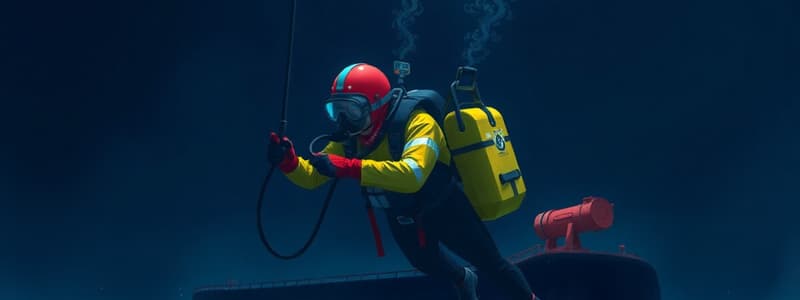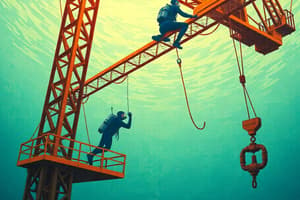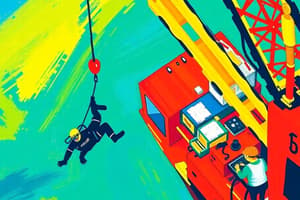Podcast
Questions and Answers
During the subsea spool tie-in operations, what primary factor led the Diving Supervisor to incorrectly assume the crane hook had reached the seabed?
During the subsea spool tie-in operations, what primary factor led the Diving Supervisor to incorrectly assume the crane hook had reached the seabed?
- Visual confirmation from underwater cameras despite poor visibility.
- Pre-operation briefings that confirmed the hook's position.
- The diver's direct confirmation that the hook was on the seabed.
- The crane operator reporting a 'no weight' reading on the crane wire. (correct)
What immediate action demonstrated effective emergency response after the crane hook struck the diver's helmet?
What immediate action demonstrated effective emergency response after the crane hook struck the diver's helmet?
- An immediate return of both divers to the dive bell and assistance from Diver 2. (correct)
- The Diving Supervisor contacted the client to assure them the diver was ok.
- A complete halt to all subsea operations and the immediate start of a toolbox talk.
- A detailed inspection of the crane hook for defects.
Which procedural improvement directly addresses the root cause of the crane hook incident during subsea operations?
Which procedural improvement directly addresses the root cause of the crane hook incident during subsea operations?
- Updating project procedures to specify minimum pennant lengths. (correct)
- Conducting more frequent toolbox talks on general safety.
- Requiring divers to wear additional safety equipment during all lifts.
- Implementing mandatory daily stretching exercises for dive teams.
Besides inadequate pennant length, what other key factor contributed to the crane hook striking the diver's helmet?
Besides inadequate pennant length, what other key factor contributed to the crane hook striking the diver's helmet?
What action can be taken to minimize assumptions regarding equipment position during critical subsea operations?
What action can be taken to minimize assumptions regarding equipment position during critical subsea operations?
Flashcards
Subsea Crane Hook Incident
Subsea Crane Hook Incident
During subsea operations, a crane hook struck a diver's helmet due to poor visibility and miscommunication, but the diver was unharmed thanks to helmet integrity.
Causes of Crane Hook Incident
Causes of Crane Hook Incident
Inadequate crane pennant length and poor visibility led to the crane hook slipping and striking the diver's helmet during PHF rigging disconnection.
Preventative Measures for Subsea Lifting
Preventative Measures for Subsea Lifting
Maintain safe distance, use visibility aids, reinforce communication, and minimize assumptions to prevent crane hook incidents during subsea operations.
Enhance Visibility Aids
Enhance Visibility Aids
Signup and view all the flashcards
Reinforce Communications
Reinforce Communications
Signup and view all the flashcards
Study Notes
- During subsea spool tie-in operations, a diver's helmet was struck by a crane hook.
- This safety flash was published and generated on March 6, 2025, as IMCA SF 04/25.
What Happened
- Divers were working on the seabed with poor visibility during subsea spool tie-in operations.
- After landing the pipe handling frame (PHF), the Diving Supervisor told the crane operator to lower the crane hook to the seabed for rigging disconnection.
- The crane operator reported 'no weight' on the crane wire.
- The Diving Supervisor assumed the hook had reached the seabed and instructed the diver to proceed with disconnecting the PHF.
- While the diver was positioned beneath the PHF, the crane hook unexpectedly struck the diver's helmet.
- The diver reported being unharmed and immediately returned to the dive bell, aborting the dive.
- Inspection revealed the diver's reclaim helmet was damaged beyond repair, including the side block.
- The helmet's integrity was maintained despite the impact, proving the high quality and durability of diving helmets; the diver unharmed.
What Went Right
- Diver 2 promptly assisted Diver 1, preventing injuries and ensuring both divers returned to the bell safely.
- Both divers and the crane block had locating beacons for accurate tracking.
- All procedures, lifting plans, and Job Hazard Analysis (JHA's) were followed during the operation.
- Protective equipment absorbed the impact, preventing injury to the diver.
What Went Wrong
- The crane hook came to rest on the top beam of the PHF, resulting in a 'no weight' reading and causing the crane operator to assume it had reached the seabed.
- When the diver approached the disconnection point, the hook slipped and struck the side of the diver's helmet.
What Was the Cause
- The crane pennant/stinger was not long enough, failing to provide enough distance between the divers and the crane hook.
- Poor visibility hindered the ability to accurately see the position of the crane hook.
Lessons and Actions
- Ensure there is enough distance between divers and crane hook by using a sufficiently long crane pennant/stinger during subsea operations to reduce the risk of accidental contact, especially in limited visibility conditions.
- Use enhanced visibility aids and monitoring, such as additional locating beacons, underwater cameras, or sonar, to track the position of critical equipment like the crane hook in environments with poor visibility to prevent miscalculations.
- Reinforce communications and challenge assumptions, minimizing assumptions regarding equipment position.
- The dive supervisor, crane operator, and divers should reinforce clear communication and confirmation procedures to ensure all parties are fully aware of the equipment's location.
Member Actions
- Project procedures were updated to specify minimum pennant lengths for different operations.
- Pre-operation inspections of all rigging and lifting equipment, including crane hooks and pennants, were conducted to ensure they meet safety standards and are appropriate for the operation.
- The Job Hazard Analysis (JHA) was updated to incorporate lessons learned from this incident, particularly regarding safe distances, visibility, and communication requirements for subsea lifting operations.
Studying That Suits You
Use AI to generate personalized quizzes and flashcards to suit your learning preferences.




